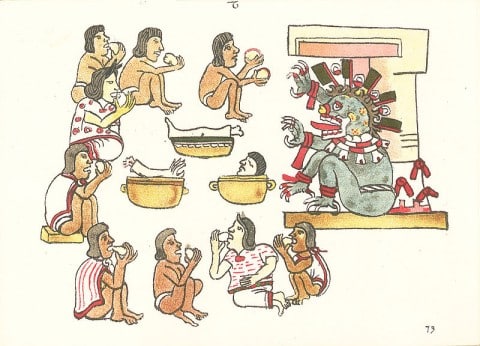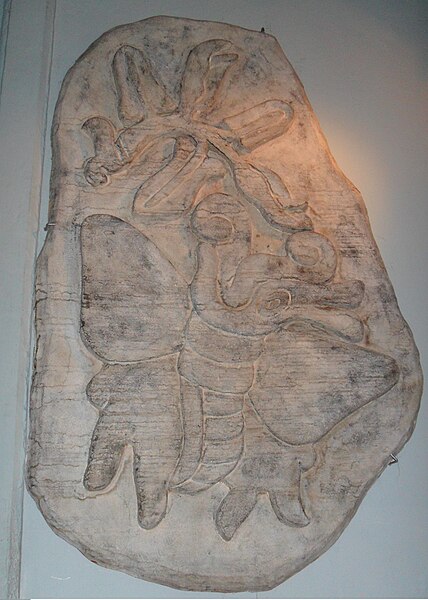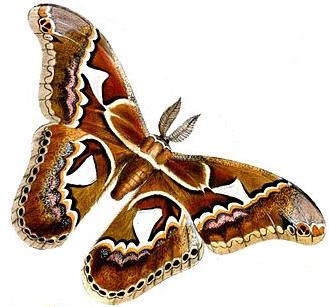Butterflies and moths are such beautiful and delicate creatures, yet there is something gloomy and morbid about them. Such is the case with the Aztec goddess Itzpapalotl, also known as the “Clawed Butterfly” or “Obsidian Butterfly.”
This duality isn’t surprising at all. So many aspects of life are full of seemingly opposite principles: life and death, love and hate, beauty and violence. Itzpapalotl and her story are perfect examples of this. If you feel intrigued by that, keep reading!
The Origin Story of Itzpapalotl
The exact origins of Itzpapalotl remain mysterious, but one legend suggests that she lived in Tonatiuhichan, a paradise where the souls of warriors went to spend the afterlife. Tonatiuhichan was a beautiful valley full of flowering gardens and breathtaking groves.
Itzpapalotl and Xociphili
According to that legend, everything was going well for Itzpapalotl for some time, but then she got banished due to her rebellious nature. She settled in Tlillan-Tlapallan, a place that was basically a middle heavenly realm.
There, she met and fell in love with Xōchipilli, a god of flowers, music, love, and dance. Xōchipilli wanted to kill the god of the daytime sky, Tonatiuh. Itzpapalotl borrowed Xōchipilli her invisible cloak, and he managed to make his murderous plan come true.
Still, even though their plan was to look innocent, other gods soon discovered their crime. Itzpapalotl and Xociphili were banished to Tlalocan, another heavenly realm where Tlaloc, the god of rain, ruled.
However, their happiness didn’t last long because Tlaloc was murdered, and Tlalocan was destroyed. Deities that lived in Tlalocan fell down to Earth or Underworld. During the flooding and destruction of Tlalocan, Xōchipilli drowned, while Itzpapalotl escaped to Tamoanchan, the underworld paradise.
Itzpapalotl in Tamoanchan
Tamoanchan was a place where gods created the first specimens of the present human race. However, it was also a paradise for the souls of stillborn children and women who died while giving birth.

Itzpapalotl became the ruler of this place, with her heart and soul darkening. She was grieving her lover, becoming more violent and bloodthirsty over time. She was so aggressive that she ambushed people and killed them.
A Two-Headed Deer
Eventually, Itzpapalotl became a divine two-headed deer, along with the goddess Cōātlīcue. Two cloud serpents, Xiuhnel and Mimich, wanted to hunt for these two goddesses, and they decided to disguise themselves as men.
However, the goddesses were a bit more cunning, so they decided to disguise themselves as two beautiful women. They approached Xiuhnel and Mimich, and Itzpapalotl persuaded Xiuhnel to drink a liquid that contained her menstrual blood.
As soon as he drank her blood, Xiuhnel lay down by Itzpapalotl and started having sex with her. All of a sudden, she tore open his chest and devoured him. Seeing this, Mimich began to run and tried to hide inside the barrel cactus. However, Itzpapalotl found and devoured him as well.
Itzpapalotl continued her bloody escapades until a group of gods decided to punish her by placing a curse on her. The curse was so powerful that whatever precious and dear our goddess had in her heart, the other gods have taken it away.
Another Version of Itzpapalotl’s Myth
There are several other versions of Itzpapalotl’s story, but this one is the most interesting one. It is also the best explanation for her role as the ruler of Tamoanchan. According to this story, she was a Chihuateteo, or “Divine Woman.”
Cihuātēotl were the souls of women who died while giving birth. Aztecs considered childbirth as equally hard, violent, and potentially deadly as fighting in a battle. So, they considered the women who died in childbirth equally as brave and heroic as warriors who died on the battlefield.
According to this legend, Itzpapalotl was once a mortal woman who died in childbirth. She became a crossroads spirit and eventually started ruling over Tamoanchan.
The Role of Itzpapalotl
As you can see, the role of this goddess in the Aztec religion and the way that Aztecs perceived her was rather complex. On one side, she was a monstrous and bloodthirsty goddess who disobeyed more powerful gods and caused many gruesome and violent deaths, both to mortals and other deities.
Aztecs feared her due to her violent and unpredictable nature. At any given moment, she could make your life hell, killing and destroying everything in her path. However, there was another side to her, one that was seemingly the complete opposite of the first side.
As the ruler of Tamoanchan, she also ruled over the souls of all infants and mothers who died during childbirth. That’s why she was also the protector of mothers, pregnant women, children, and midwives.

Itzpapalotl was violent and destructive, but she was also warm, protective, and nurturing. While Aztecs had many gods that they worshipped and feared at the same time, the duality of Itzpapalotl was unprecedented.
Tamoanchan
To paint the portrait of Itzpapalotl further, I must also describe Tamoanchan, a heavenly realm where she ruled. At one point, Tamoanchan was a place where gods created the first pair of present-day humans.
As the human population grew, Tamoanchan became the place where the souls of stillborn infants and deceased mothers came. In Tamoanchan, there was a so-called Suckling Tree, and it had 400,000 nipples. The souls of deceased babies could suckle on those nipples, gaining strength to reincarnate and get born again.
The Duality of Itzpapalotl
Even though Itzpapalotl could bring suffering and destruction, she also ruled over a place that offered solace and new hope. At the same time, she embodied death and rebirth. She was a monster and a savior.
For some people, she brought horror and suffering, while for others, she brought comfort, help, and hope. For someone who isn’t familiar with the culture and religion of the Aztecs, this duality can seem illogical and contradictory.
However, the Aztecs didn’t look at life and death (or joy and suffering) as two separate things. For them, life and death were simply two parts of one cycle. Death wasn’t the opposite of life; it was a part of it.
That’s why Itzpapalotl’s behavior shouldn’t be too surprising to you. She is unpredictable, but so is life. The life that we hang on to so desperately. Life is full of suffering, pain, and horror. But on the other side, just like it makes us go through many bad things, life also gives us hope, comfort, and a chance for new beginnings.
Blood and Hope
However, just because life is sometimes good to us doesn’t mean that all the bad things are forgotten and that they don’t matter anymore. That’s not the point of life, to go through some bad things and then be rewarded with nice things. Such thinking is too naive.
Bad things will simply happen, as well as the nice things. They don’t have to be correlated or to be 50:50. Such is the case with Itzpapalotl. Just because she watches over the souls of stillborn infants and gives them comfort, it doesn’t erase what she does when her rage and thirst for blood overcomes her.
That also means that these violent outbursts of Itzpapalotl nullify her protective and nurturing side. Itzpapalotl, life, and even people, everything has two sides. These two sides don’t cancel each other out. They simply coexist within everything and everyone.
For some people, the dual nature of this goddess represents all the sacrifices we need to make in our lives to achieve happiness.
The Description and Appearance of Itzpapalotl
Knowing that she was also known as Clawed Butterfly or Obsidian Butterfly, it is easy to guess some things about her appearance. She was often depicted as a skeletal woman with butterfly wings and eagle (or sometimes jaguar) claws.
On their edges, Itzpapalotl’s wings had claws or obsidian blades, and that’s how she got her name. Sometimes, she took the form of a beautiful young woman. In other cases, she existed as a two-headed deer.
Additionally, since the phrase “clawed butterfly” can also refer to a bat, some depictions of her showed her as a bat. In other instances, she was in the form of a moth.
Do you remember the part in which I mentioned that Aztecs considered childbirth as heroic as fighting a battle? They saw the women who died in childbirth as equally heroic as the warriors who died on the battlefield.
For that reason, some depictions of Itzpapalotl portray her as a woman with flowing long hair and holding a trophy leg, as a sign of war trophy and victory.

The Itzpapalotl Rituals and Festivities
In the Aztec calendar, Itzpapalotl is celebrated on Trecena 1 House. This date is one of five dates in the year during which Aztecs paid their respects to the women who died in childbirth.
The rituals devoted to her were also connected to the myth of the creation of Chichimec. In one document dating back to the 16th century, she is shown standing in front of a seven-chambered cave, out of which several Chichimec warriors are emerging.
In the late 20th century, archeologists have shown several other caves that were carved to emulate the seven-chambered cave behind Itzpapalotl.
Itzpapalotl’s Relationship with Other Aztec Goddesses
According to what I know about her, Itzpapalotl doesn’t have many close relationships with other goddesses. When she took the form of a two-headed deer, she did it alongside Cōātlīcue, a mother goddess of fertility.
The connection between these two goddesses is rather subtle yet powerful. Cōātlīcue was a goddess of life, sacrifice, and rebirth, which is similar to Itzpapalotl. While Itzpapalotl isn’t a motherly deity, she offers a chance of rebirth, and, as I already said, she represents all the things we need to sacrifice in order to be happy.
On the other side, we can also draw a parallel between her and Xochiquetzal, the goddess of love, beauty, and fertility. In some versions of his story, Xōchipilli, Itzpapalotl’s lover, was also a lover of Xochiquetzal.
Apart from sharing a taste in men (in this case, gods), these two goddesses both have close ties to women, fertility, and motherhood.
Finally, her role in ruling an underground paradise is similar to Mictecacihuatl’s rule over the Underworld. Additionally, Mictecacihuatl was sacrificed as an infant, and Itzpapalotl protected the souls of deceased infants.
Itzpapalotl and Other Religions
Across different religions and cultures, there are certain goddess archetypes. We can find these archetypes in almost every religion. That means that we can easily pinpoint a certain goddess and find another goddess from a different religion that’s basically the same deity with the same characteristics, powers, and roles. Or, almost the same.
However, Itzpapalotl and her story are rather unique, and no goddesses from other religions are the same (or almost the same) as her. However, there are goddesses that carry certain similarities to her.
For example, the Hindu goddess Kali symbolizes death and destruction, but just like Itzpapalotl, she has a much more complex role. Itzpapalotl is also a goddess of fertility, which makes her similar to other fertility goddesses, such as Freyja, Isis, and Demeter.
Morrigan, a Celtic goddess of death, war, and transformation, is also somewhat similar to Itzpapalotl. Finally, a butterfly is a symbol of both Itzpapalotl and Psyche, a Greek goddess of soul, which makes a nice and interesting connection between the two goddesses.
Itzpapalotl’s Legacy
Itzpapalotl is a complex deity that embodies so many opposite concepts: blood and beauty, destruction and comfort, violence and new hope. She is almost like a Yin Yang, but with this goddess, there is no guarantee that you will experience equal amounts of happiness and tragedy.
She reminds us that this world and our lives can be cruel and filled with unpredictable tragedies. We can’t count on the universe to be fair to use. However, there is always hope that we can start over and rise again, no matter how low we fall.

As a goddess with butterfly wings, Itzpapalotl is the goddess of transformation. Just like a butterfly transforms from a caterpillar into its beautiful final form, we also need to go through certain transformations.
These transformations can be painful, but they are necessary. Nothing in this life can stay the same forever. Everything changes and transforms into something else, no matter how hard we try to resist the change.
Itzpapalotl Symbols
Just like all other gods and goddesses, Itzpapalotl has certain symbols. Sometimes, we determine those symbols based on artistic depictions, while other symbols play a vital role in the story of said god or goddess. In any case, these symbols can help us connect with a certain deity, and if you want to connect to Itzpapalotl, look for these symbols:
General
Probably the most logical symbol of this goddess is butterfly wings. They are both beautiful, yet so tragic and gloomy, just like Itzpapalotl. Alternatively, moth or bat wings are just as good choices.

Another great choice is a skeleton because she often takes the form of a skeleton woman or a “normal” woman who has a skull instead of a whole head. Caves, especially those with seven chambers, are another symbol of Itzpapalotl.
Animals
Obviously, the main animal symbol of Itzpapalotl is a butterfly. However, even moths are good symbols, especially the Orizaba silkmoth (Rothschildia orizaba). This moth lives in Mexico and other parts of Central and South America. People often compare it to Itzpapalotl due to its unique beauty and wings that look like they are lined with tiny daggers
Other animals that symbolize Itzpapalotl are bats, eagles, jaguars, and deer. All these animals appear in the descriptions of Itzpapalotl, which makes them perfect choices for Itzpapalotl symbols.
Plants
As far as I know, there are no plants that symbolize Itzpapalotl, or at least we haven’t discovered mentions of such plants. However, plants that symbolize death, rebirth, fertility, and transformation could also be great symbols for Itzpapalotl.
For example, Marigold flowers are native to the regions where Aztecs lived, and these flowers symbolize death. The agave plant, with its sharp spikes, could also symbolize Itzpapalotl and her sharp wings.
There is also a widely spread forget-me-not flower. Many people wear it during the month of October, especially on October 15th, which is the Pregnancy and Infant Loss Awareness Day.
Perfumes/Scents
A perfume that could symbolize Itzpapalotl would need to contain scent notes that symbolize both beauty and death. Patchouli, vetiver, amber, jasmine, bergamot, and cypress are good choices to use as symbols of Itzpapalotl.
Gems and Metals
Obsidian symbolized Itzpapalotl because her wings were made of it. The symbolism goes even deeper than that because obsidian is a type of volcanic glass, and volcanoes are famous for their destructiveness and unpredictability, just like Itzpapalotl.
Colors
In one of the manuscripts describing Itzpapalotl, we can find that she “blossomed into the white flint,” which makes white a good color symbol for this goddess. Since she is also the goddess of death, destruction, and bloodshed, black and red also suit her well.
Meditations to Invoke the Goddess Itzpapalotl
- Obsidian Butterfly, help me transform into a better and stronger version of myself.
- Powerful goddess, guide me from darkness to the light.
- With your obsidian wings, cut through my confusion and help me see clearly.
- Teach me how to let go of the things I have lost, oh mighty goddess.
- Don’t let this be my end: give me the strength to start anew.
Want to Bring More Itzpapalotl Qualities in Your Life?
- No matter how much they stress you out, embrace the changes in your life and try to make the best out of them. If you hold on too long to the way things were before, you will forever stay in the past. When everything is too still in your life, don’t be afraid to start a change. Move to a new city, find a new job, and meet new people.
- Don’t be afraid to start over. Even if something hasn’t worked out for you, learn something from the experience and try again. It is never too late to get a new chance; just don’t give up. This is true even for some seemingly small things. For example, if you dropped out of college years ago, start over. If you have stopped practicing sports or going to the gym, start again. Did you fail an exam? Study and try again.
- Even in your darkest moments, remember to stay kind, supportive, and nurturing to your dear ones. Whenever you feel like you will burst from stress, frustration, or anger, remember that even Itzpapalotl could find kindness inside of her.
Featured Image Credit: This image was created with Adobe Photoshop., Public domain, via Wikimedia Commons

